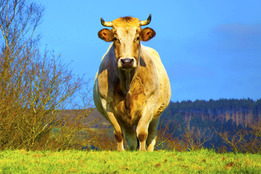
Adjectives and nouns sometimes seem to come in pairs. There’s a magnetic connection between words such as delicious and meal or comfortable and shoes. Some of these pairings are so common that they nearly become idioms: frozen tundra and latest technology and blazing fire and existential angst and filthy habit.
But if the pairing delicious meal depends on circumstance (some meals are, sadly, not delicious), there are also pairings that are seemingly more limited and depend as much on linguistic habit and usage and history as on any precise circumstances. Take our use of the adjective handsome, for instance.
English does not have grammatical gender—nouns are not classified as “masculine” or “feminine” as they are in other European languages. But we do have words that indicate gender, like man or girl, stallion or mare, rooster or chicken. There is no grammatical agreement for gender for adjectives in English, but there is the weight of precedent. The frequency with which we encounter any given pairing influences the way we ourselves use a given adjective.
We typically use handsome to refer to an attractive man, and beautiful to refer to an attractive woman. But these uses aren’t governed by grammar, they are governed by convention. The fact is, handsome woman was formerly much more commonly used than it is today; a corpus of English text before 1700 shows that handsome woman was used ten times more frequently than beautiful man. A similar search for the same two-word pairs in a corpus of text published in the past twelve years shows a remarkable flip, with beautiful man occurring nearly twenty times more frequently than handsome woman.
Even though their current use is more or less parallel in meaning, handsome and beautiful have very different histories. These histories are observable in the spelling of these words: beautiful meaning “full of beauty,” coming from the French word beauté. Handsome originally meant “well-suited to the hands” of a tool or weapon, then jumped from referring to the thing wielded to the person doing the wielding to mean “good with the hands” or “dexterous.” It then came to mean “clever” or “fitting.” This idea of appropriateness or suitability led handsome to mean “elegant, well-proportioned,” and finally a rough synonym of beautiful.
This history of handsome shows that the word always had essentially pragmatic roots in English, rather than the purely esthetic meanings of beautiful through time. Maybe this deep background of the word’s use has contributed to the evolution of handsome as a near-synonym of beautiful, but one with different connotations. Shakespeare used handsome of a woman in The Two Noble Kinsmen:
His mother was a wondrous handsome woman;
His face methinks goes that way.
Its other uses in literature are many:
There is one thing, however, in it at present very handsome; and that is, the inn-keeper’s daughter. —Laurence Sterne, Tristram Shandy 1759
Lady Middleton was not more than six or seven and twenty; her face was handsome, her figure tall and striking, and her address graceful. —Jane Austen, Sense and Sensibility, 1811
Mary Jane straightened herself up, and my, but she was handsome! —Mark Twain Huckleberry Finn 1884
She was still handsome and bore every sign of having in her youth been a very lovely woman. —Arthur Conan Doyle The Disappearance of Lady Frances Carfax, 1911
May is a darling; I've seen no young girl in New York so handsome and so intelligent. —Edith Wharton, Age of Innocence, 1920
Mrs. Cavendish, who had married John’s father when he was a widower with two sons, had been a handsome woman of middle-age as I remembered her. —Agatha Christie, The Mysterious Affair at Styles, 1920
We can perhaps see that the word’s use in the 20th century showed a slight change in meaning: usually used to connote attractiveness, yes, but of a homey, comfortable, and unromantic kind. Ian Fleming’s use of the word in Casino Royale (1953) is a typical example: “She was younger than her husband, chubby and handsome and warm-eyed.” In journalistic writing, we see handsome used to describe a woman in TIME magazine into the 1980s, most often as “handsome wife.”
So handsome is settling into an identity after more than four hundred years of usage. It is coming to mean something slightly different when used of a man or of a woman, showing that parallel adjectives are not perfectly logical or equal. As a term for a slightly older, slightly serious woman, it forms an interesting pair with the use of our term for a slightly younger, slightly unserious man: pretty boy.




